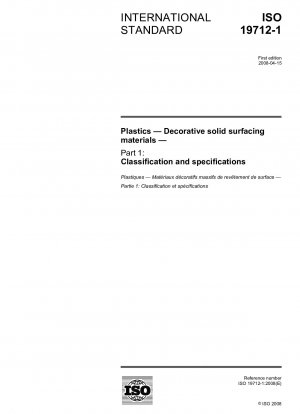ISO 19712-1:2008
Plastics - Decorative solid surfacing materials - Part 1: Classification and specifications
- Standard No.
- ISO 19712-1:2008
- Release Date
- 2008
- Published By
- International Organization for Standardization (ISO)
- Latest
- ISO 19712-1:2008
- Scope
- This part of ISO 19712 establishes a classification system for solid surfacing materials according to their performance. This part of ISO 19712 also specifies property requirements for the various types of solid surfacing materials covered by this classification. Requirements are specified for the types that are most generally used, but additional types may be added as required. The specified limit values apply to the most commonly used types of material, but within each classification it may be possible to obtain variants having much higher performance values. These materials are characterized by their homogeneous appearance, renewable surfaces and inconspicuous seams. They are generally classified as follows. a) Solid surface sheets Solid surfacing sheets are designed for horizontal, vertical, wet and dry applications. b) Solid surface shapes Solid surface shapes include, but are not limited to, kitchen sinks, bathroom sinks, vanity tops, showers, tubs and spas. The important properties of solid surfacing materials are - water resistance, - thermal shock resistance, - heat resistance, - impact resistance, - stain and chemical resistance, - cigarette burn resistance, - colour stability, - hardness, - bacterial and fungal resistance, - cleanability, - hygiene, - seamability, - renewability.
ISO 19712-1:2008 Referenced Document
- ISO 19712-2:2007 Plastics - Decorative solid surfacing materials - Part 2: Determination of properties - Sheet goods
- ISO 19712-3:2007 Plastics - Decorative solid surfacing materials - Part 3: Determination of properties - Solid surface shapes
ISO 19712-1:2008 history
- 2008 ISO 19712-1:2008 Plastics - Decorative solid surfacing materials - Part 1: Classification and specifications
